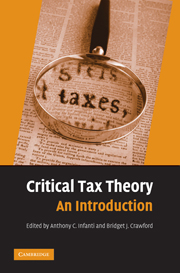Book contents
- Frontmatter
- Contents
- List of Illustrations
- List of Tables
- List of Contributors
- List of Common Abbreviations
- Introduction
- CHAPTER 1 FOUNDATIONS OF CRITICAL TAX THEORY
- CHAPTER 2 HISTORICAL PERSPECTIVES ON TAXATION
- CHAPTER 3 THE GOALS OF TAX POLICY
- CHAPTER 4 CRITICAL TAX THEORY MEETS PRACTICE
- CHAPTER 5 RACE AND TAXATION
- CHAPTER 6 GENDER AND TAXATION
- CHAPTER 7 SEXUAL ORIENTATION AND TAXATION
- CHAPTER 8 THE FAMILY AND TAXATION
- CHAPTER 9 CLASS AND TAXATION
- CHAPTER 10 DISABILITY AND TAXATION
- Tax and Disability: Ability to Pay and the Taxation of Difference
- Enabling Work for People with Disabilities: A Post-Integrationist Revision of Underutilized Tax Incentives
- Disability and the Income Tax
- CHAPTER 11 GLOBAL CRITICAL PERSPECTIVES ON TAXATION
- CHAPTER 12 CRITICAL PERSPECTIVES ON CRITICAL TAX THEORY
- Index
Tax and Disability: Ability to Pay and the Taxation of Difference
Published online by Cambridge University Press: 04 August 2010
- Frontmatter
- Contents
- List of Illustrations
- List of Tables
- List of Contributors
- List of Common Abbreviations
- Introduction
- CHAPTER 1 FOUNDATIONS OF CRITICAL TAX THEORY
- CHAPTER 2 HISTORICAL PERSPECTIVES ON TAXATION
- CHAPTER 3 THE GOALS OF TAX POLICY
- CHAPTER 4 CRITICAL TAX THEORY MEETS PRACTICE
- CHAPTER 5 RACE AND TAXATION
- CHAPTER 6 GENDER AND TAXATION
- CHAPTER 7 SEXUAL ORIENTATION AND TAXATION
- CHAPTER 8 THE FAMILY AND TAXATION
- CHAPTER 9 CLASS AND TAXATION
- CHAPTER 10 DISABILITY AND TAXATION
- Tax and Disability: Ability to Pay and the Taxation of Difference
- Enabling Work for People with Disabilities: A Post-Integrationist Revision of Underutilized Tax Incentives
- Disability and the Income Tax
- CHAPTER 11 GLOBAL CRITICAL PERSPECTIVES ON TAXATION
- CHAPTER 12 CRITICAL PERSPECTIVES ON CRITICAL TAX THEORY
- Index
Summary
INTRODUCTION
The Census Bureau estimates that at the end of 1994, approximately 54,000,000 Americans (over 20% of the U.S. population) had some type of disability; 26,000,000, a severe disability. Since that time, the U.S. population has both grown and aged; the number of people with disabilities is therefore probably larger today. The Code contains numerous discrete and largely uncoordinated provisions dealing with or of particular relevance to people with disabilities. Yet so far as we have been able to ascertain, no serious academic analysis of the policy issues underlying the U.S. taxation of people with disabilities or of those who interact most closely with them has ever been published. Disability and tax scholars, each largely ignorant of the others' specialties, appear for the most part to have avoided the subject. This is regrettable. Tax rules of particular relevance to people with disabilities are too important for disability specialists to ignore in assessing federal disability policy. Conversely, the problems of people with disabilities raise issues that go to the heart of income tax theory and policy.
Disability theory has changed markedly over the past century. The early 1900s saw the replacement of an affliction paradigm, in which disability was viewed as a punishment or test imposed by God, with a medical/charity paradigm, in which people with disabilities came to be viewed instead as appropriate objects of pity and philanthropy. The result was the enactment of a wide variety of special programs to help Americans with disabilities.
- Type
- Chapter
- Information
- Critical Tax TheoryAn Introduction, pp. 300 - 307Publisher: Cambridge University PressPrint publication year: 2009



